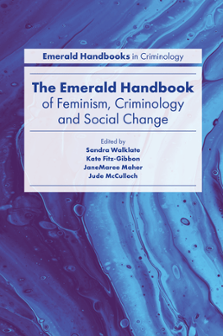
Index
The Emerald Handbook of Feminism, Criminology and Social Change
ISBN: 978-1-78769-956-4, eISBN: 978-1-78769-955-7
Publication date: 2 July 2020
Citation
(2020), "Index", Walklate, S., Fitz-Gibbon, K., Maher, J. and McCulloch, J. (Ed.) The Emerald Handbook of Feminism, Criminology and Social Change (Emerald Studies in Criminology, Feminism and Social Change), Emerald Publishing Limited, Leeds, pp. 401-410. https://doi.org/10.1108/978-1-78769-955-720201032
Publisher
:Emerald Publishing Limited
Copyright © 2020 Emerald Publishing Limited
INDEX
Index
Note: Page numbers followed by “n” indicate footnotes.
- Prelims
- Part One: The Origins of Feminist Criminology
- Introduction to Part One
- Chapter 1: Evolving Feminist Perspectives in Criminology and Victimology and Their Influence on Understandings of, and Responses to, Intimate Partner Violence
- Chapter 2: Feminist Perspectives in Criminology: Early Feminist Perspectives
- Chapter 3: Feminist Approaches to Victimology
- Chapter 4: Feminist Activism and Scholarship in Resisting and Responding to Gender-based Abuse
- Chapter 5: Feminist Criminology in a Time of ‘Digital Feminism’: Can the #MeToo Movement Create Fundamental Cultural Change?
- Part Two: Research Beyond the Global North
- Introduction to Part Two
- Chapter 6: Gender Violence Law Reform and Feminist Criminology in Brazil
- Chapter 7: The Contribution of Critical Ecofeminism to the Criminological Debate in Spain: Debating All Rules of All Tribes
- Chapter 8: Public Attitude Towards Rape Crime and the Treatment of Its Victims in Delhi City
- Chapter 9: On Honour, Culture and Violence Against Women in Black and Minority Ethnic Communities
- Part Three: Extending the Criminological Agenda
- Introduction to Part Three
- Chapter 10: Masculinities and Interpersonal Violence
- Chapter 11: Disrupting the Boundaries of the Academe: Co-creating Knowledge and Sex Work ‘Academic-activism’
- Chapter 12: Social Change and the Banality of Patriarchal Oppression and Gender Inequality
- Chapter 13: Reflections on Women’s Resistance and Social Change in Africa
- Chapter 14: Speaking Life, Speaking Death: Jerusalemite Children Confronting Israel’s Technologies of Violence
- Chapter 15: Caught between a Rock and a Hard Place – Human Rights, Life Imprisonment and Gender Stereotyping: A Critical Analysis of Khamtokhu and Aksenchik v. Russia (2017)
- Part Four: Looking to the Future
- Introduction to Part Four
- Chapter 16: Bringing Racialised Women and Girls into View: An Intersectional Approach to Punishment and Incarceration
- Chapter 17: Technology and Violence Against Women
- Chapter 18: Enhancing Feminist Understandings of Violence Against Women: Looking to the Future
- Chapter 19: Criminological Lessons on/from Sexual Violence
- Chapter 20: Gender-based Violence: Case Studies from the Global South
- Chapter 21: Postscript. Feminism, Activism and Social Change: A Call to Action for Feminist Criminology
- Index